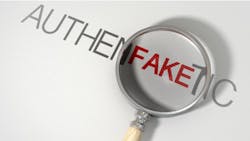Counterfeit parts and components are no joke for Uncle Sam. Last year, a metals manufacturer faked test results and provided faulty materials to NASA, causing more than $700 million in losses and two failed satellite launch missions. The fraud involved Sapa Profiles Inc., which falsified thousands of certifications for aluminum parts over 19 years for hundreds of customers, including NASA, according to Bloomberg.
The bad parts were used to make the Taurus XL rocket, which was supposed to deliver satellites studying the Earth’s climate during missions carried out in 2009 and 2011. The launch vehicle’s fairing—a clamshell structure that carries the satellite as it travels through the atmosphere— didn’t fully open, causing the unsuccessful launch, Bloomberg reports.
Stemming Counterfeit Electronics
In an effort to stem its contractors’ and subcontractors’ use of counterfeit electronic parts, NASA is proposing an amendment to its Federal Acquisition Regulation Supplement. If approved, the amendment will add new text requiring covered contractors and subcontractors to use electronic parts that are currently in production and purchased from the original parts manufacturers, their authorized dealers, or suppliers that get their parts from OEMs (or their authorized dealers).
If the contractor does not purchase electronic parts according to these new rules, it must purchase the parts from a NASA-identified supplier or contractor-approved supplier, the agency reports. The contractor then assumes responsibility and is required to inspect, test and validate authentication of the parts. According to NASA, the contractor will also be required to obtain traceability information and provide this information to the contracting officer upon request. The selection of contractor-approved suppliers is subject to review and audit by the contracting officer.
This proposed rule implements section 823(c)(2)(B) of Public Law 115– 10, the NASA Transition Authorization Act of 2017. It stems from a 2009/2010 investigation that uncovered 1,800 cases and more than 1 million counterfeit parts. “This exposed the threat counterfeit parts pose to service members and national security,” NASA stated in a January announcement.
Since 2010, the Comptroller General of the United States has discussed in three reports the risks and challenges associated with counterfeit parts and counterfeit prevention at both the Department of Defense (DoD) and NASA, including inconsistent definitions of counterfeit parts, poorly targeted quality control practices and other potential barriers to improvements to these practices. NASA is currently accepting comments on the proposed rule, which must be submitted on or before March 9 for consideration in the formation of a final rule.
A Three-Pronged Crackdown
In a separate-but-related development, the DoD, the General Services Administration (GSA), and NASA issued the final rule amending the Federal Acquisition Regulation (FAR). It requires contractors and subcontractors to report to the Government-Industry Data Exchange Program (GIDEP) certain counterfeit or suspect counterfeit parts and certain major or critical nonconformances. The rule went into effect on Dec. 23.
“Counterfeits are not produced to meet higher-level quality standards required in mission critical applications and are a significant risk in causing failures to systems vital to an agency’s mission,” The Federal Register reports. “For weapons, space flight, aviation, and satellite systems, these failures can result in the death, severe injuries, and millions of dollars in system damage or loss.”
For example, if counterfeits are installed in a missile’s guidance system, that missile may not function at all, may not proceed to its intended target or may strike a completely unintended location, resulting in catastrophic losses. “Defense, space, and aviation systems in particular must meet rigorous component specifications,” it continues. “Failure of even a single one can be catastrophic causing serious problems and placing personnel and the public in harm’s way.”
According to The Federal Register, this rule focuses on complex items with critical applications where the failure of the item could injure personnel or jeopardize a vital agency mission. For example, uncertified electronic connectors once shut down large parts of the defense and space industrial base production for six months until solutions to certification could be devised.
In “NASA Moves To Curb Contractors’ Use Of Counterfeits,” Daniel Wilson cited Roger Waldron, president of the Coalition for Government Procurement, as saying that the new rules highlight the evolving challenges associated with assuring the integrity of the government's commercial supply chain: “This rule and other initiatives addressing supply chain challenges could have significant impact on commercial item acquisition initiatives, like e-commerce.”
About the Author

Bridget McCrea
Contributing Writer | Supply Chain Connect
Bridget McCrea is a freelance writer who covers business and technology for various publications.







